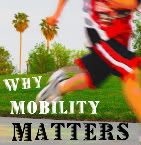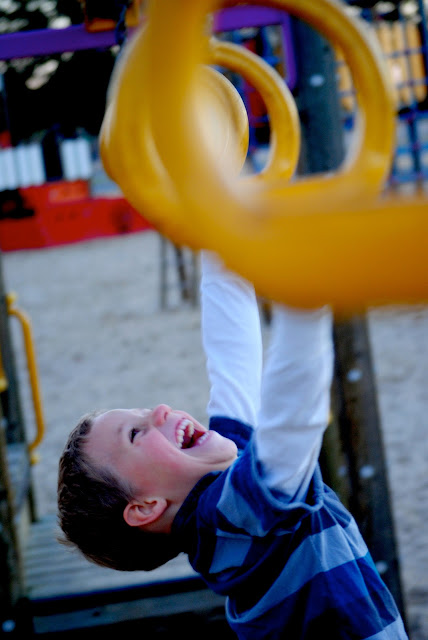Hunter at 14 months, signing "please" and "ball" while simultaneous verbalizing "ball"
I look back and our journey with baby sign language with great fondness and appreciation.
It was long before we heard about Doman, or many of the other early learning topics I now am familiar with, but it nonetheless found its way into our lives in an unexpected way and I now can't imagine how his early toddlerhood would have been without it.
Before Hunter was born and during his early infancy, I had never heard of the concept as this was back in 2005 and in the very beginning of the "trend". When Hunter was four months old, with my mom's prompting I ordered the book
Baby Signs: How to Talk with Your Baby Before Your Baby Can Talk from a catalog.
How thrilled I was for the exciting possibilities!
At five months I started teaching him some sign language. I don't remember how many signs I tried to teach him in the beginning, but at seven months I was ecstatic when he finally reproduced his first sign: more.
Thereafter, he discovered the power of this type of communication and began using the sign "more" for pretty much
everything. It seemed like the sign evolved to mean "
I want" more than its actual definition.
Perhaps because of the versatility of this sign, he didn't mimic any more signs for what seemed like an eternity. Until finally, at eleven months old, he had some sort of signing breakthrough.
Within a month, he learned to sign "
all done," "
eat," "
drink," "
hot," "
up," (
his was slightly different) and "
night night."
At twelve months he learned the ever-popular "
please," followed by "
hair brush", "
phone", "
toothbrush," and "
hat".
By thirteen and fourteen months he learned "
down," "
come," "
thank you," "
water," "
book," and "
bath," followed by "
milk," "
dog," "
ball," "
outside," and "Cheerios" (
which he made up - would pinch his thumb and forefinger together).
And then, it seemed like just as soon as our signing adventure had begun, it was over.
At fifteen months he began talking a great deal - within that month he learned to say almost two dozen words, whereas before he could only say a handful. He still used sign language, and that month picked up the new signs of "
yes", "
car", and, some things I never got a chance to get a picture of - "
no", "
hair", "
listen", "
headphones", and "iPod" (
yes, he made up the sign for iPod too - it involved him sticking his forefinger and thumb in both ears as if he were putting in earbuds).
Then, the next month, he started really talking. In fact,
even to a mother who had religiously written down every single possible milestone since he was born, from "first visit to the mall" to "first bandaid" to, well, pretty much everything, he had me beaten. He was learning to say new words at a rate that even I couldn't keep up with, and things just set off from there.
And that was about it.
For a long time he continued to often use his signs along with the spoken words, as you can see in the above video of him signing and saying "ball" and "please". In fact, certain signs, such as
please, stuck with him until he was probably two and a half - he would always rub his stomach while saying "please"! But from that point on, he didn't really learn any new signs, simply because he could pretty much say everything verbally, and preferred communicating that way. And in spite of my intention to keep them in our life (
as sort of a foreign language experience), they ended up falling by the wayside and fading into the past.
I was definitely surprised, and a little bit saddened, when it ended so soon. I had so many signs that I wanted to teach him, and it was all so much fun! But the experience definitely enriched our lives, and as I said, I couldn't imagine his early toddlerhood without it.
Giving him the tools to communicate without whining was so incredibly priceless. He could say if he wanted up or down, if he was thirsty, if he was tired, if he wanted to go outside, even talk to me about what he saw or wanted, such as a ball or the dog. It's so hard to imagine how this period of life would have gone
without him having these tools, and thankfully I don't have to.
And even though it was hard to see it go,
it served its purpose, and that's what counts.
Looking beyond the temporary benefits of tools of communication, another thing I am thankful for is the benefit it served him for the rest of his lifetime. As
this study showed,
Results of the study revealed that 24-month-old babies using baby sign language were on average talking more like 27- or 28-month-olds, representing more than a three-month advantage over the non-signers. The babies using baby sign language were also putting together significantly longer sentences. In addition, 36-month-old signers on average were talking like 47-month-olds, putting them almost a full year ahead of their average age mates. At 8 years, those who had used sign language as babies scored an average of 12 points higher in IQ on the WISC-III than their non-signing peers.
That is another reason I look so fondly on it, as it was one of our first "early learning" endeavors. And I know that even just in that short time period, it gave him a boost for the rest of his life.
It was definitely a fun adventure.
It didn't always go as expected. It ended a lot sooner than I thought it would. He started talking a lot earlier than I was prepared for. He surprised me by making up his own signs, or by his funny interpretations of the signs I taught him. He never did sign a lot of words I taught him for months, such as "
mom" or "
help." He even did something I never anticipated, and started signing in two- and three-word sentences, such as "drink water please".
But all in all, isn't that how all parenting tends to go? Not exactly how we expected?
I'm very thankful to have had this wonderful chance to learn together with my baby. And I can't wait to start with the next one!
"And it shall be for a sign unto thee upon thine hand..."
Exodus 13:9
What about you? What was your experience with baby signs?















